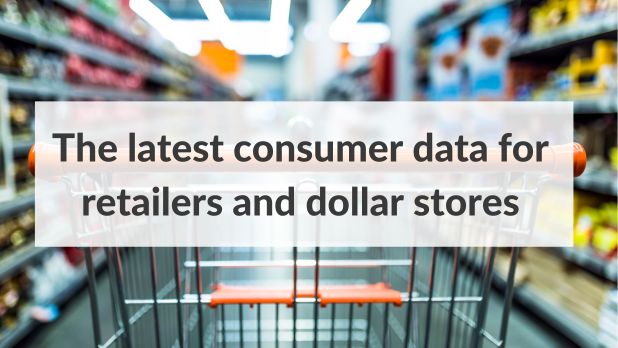Top Retail Trends Enhancing Shopping Experiences
Retail trends and technologies, such as virtual queues, self-checkout, augmented reality (AR), virtual reality (VR), and retail media networks, are...

The future of online shopping looks incredibly promising, with e-commerce spending projected to reach $1.2 trillion in 2024.
To understand how shopping habits are evolving, we surveyed over 1,500 customers across North America. Our Retail Technology Consumer Perception Survey explores differences in shopping habits by age, the rise of chatbots, the impact of personalized advertising, and advancements in retail AI technology.
Curious about how these online shopping trends are shaping the future of digital retail? Download the infographic with detailed data by clicking below, or keep reading for a closer look at the key findings.
Our survey reveals a generational divide in how different age groups shop online. Among consumers under 45, over 48% reported shopping online more frequently since last year, while the frequency of online shopping among those 45 and over has increased by an average of 36%.
Respondents under 45 show higher engagement with new technologies, such as chatbots and AI-driven shopping tools. However, those aged 45 and above are less likely to use AI technologies or chatbots. Privacy concerns and unfamiliarity with these tools are common barriers.
To cater to this older demographic, retailers should focus on educating them about the benefits and ensuring the privacy and security of these technologies. Building trust is key to encouraging broader adoption among older consumers.
When it comes to online shopping, the top factors influencing purchase decisions are product availability (23%), delivery speed (21%), and fees (20%).
These elements are crucial for all shoppers, but delivery speed is especially important for younger consumers aged 18-34. This demographic consistently prioritizes quick delivery over other factors, highlighting the need for retailers to streamline logistics and ensure fast shipping options.

Services like Amazon Prime have set a high standard for online retailers, offering same-day or next-day delivery for many items. Brands that can't match these customers’ expectations may lose out to competitors.
Studies found that 88% of consumers are willing to pay for same-day or faster delivery. Retailers can leverage this trend by offering various shipping options, including expedited delivery on minimum orders.
Chatbots are gaining significant acceptance, especially among younger shoppers.
The survey shows that over half of consumers under 45 have used a chatbot on a retailer’s website, and a majority (82%) find it capable of meeting their needs.
Younger shoppers, especially those in the 18-34 age range, are more tech-savvy and probably more comfortable interacting with chatbots.
These AI-powered assistants provide immediate responses to queries, helping customers with everything from customer support to shipping information. This aligns well with the expectations of today’s shoppers who seek quick and efficient service.
Over 60% of the surveyed consumers have received customized advertisements, and many (55%) have noticed online stores dynamically adjusting content based on their interests.
This personalization is generally well-received, with 34% of consumers expressing positive sentiments towards AI-enhanced shopping experiences.
AI and machine learning algorithms analyze vast amounts of data to understand consumer preferences and predict future behavior. This allows retailers to offer more relevant products, increasing customer engagement and conversion rates.
For instance, Sephora uses AI-driven product recommendations and virtual try-ons based on customers’ beauty preferences and previous purchases. With AI and digital innovations, the giant beauty retailer has drastically increased its e-commerce sales over the past years.
AI technology is revolutionizing the online shopping experience, with tools like virtual try-ons and virtual assistants becoming increasingly popular. While many consumers have embraced these innovations, some remain hesitant due to privacy concerns or unfamiliarity with the technology.
The survey revealed the top three reasons consumers had not tried AI technology while online shopping:

However, an encouraging 47% reported positive experiences among those who have used AI tools. This highlights an opportunity for retailers to foster adoption by educating customers about the benefits and ease of use of AI technologies.
The rise of AI in online shopping is transforming how consumers interact with online retailers. Virtual try-ons and AI chatbots enhance the shopping experience by providing personalized, convenient, and engaging interactions.
To maximize the benefits of AI technologies, retailers should focus on educating customers, addressing privacy concerns, and ensuring user-friendly experiences. By doing so, they can foster greater adoption and drive customer satisfaction in the evolving e-commerce landscape.
At Intouch, we help over 300 brands better understand and meet customer needs. Our customer experience (CX) solutions can help you achieve operational excellence and build long-term customer relationships - in-store or online.
Let’s chat about how we can help you get insights into your customer's needs and help your brand thrive in the digital age.

Retail trends and technologies, such as virtual queues, self-checkout, augmented reality (AR), virtual reality (VR), and retail media networks, are...

Technology is continuously evolving the way in which consumers interact with brands. And it’s imperative for businesses to keep up with these trends...

As we all get ready to jump into a new year, we have one last Flash Points consumer data round-up for 2023. This time we’re asking: